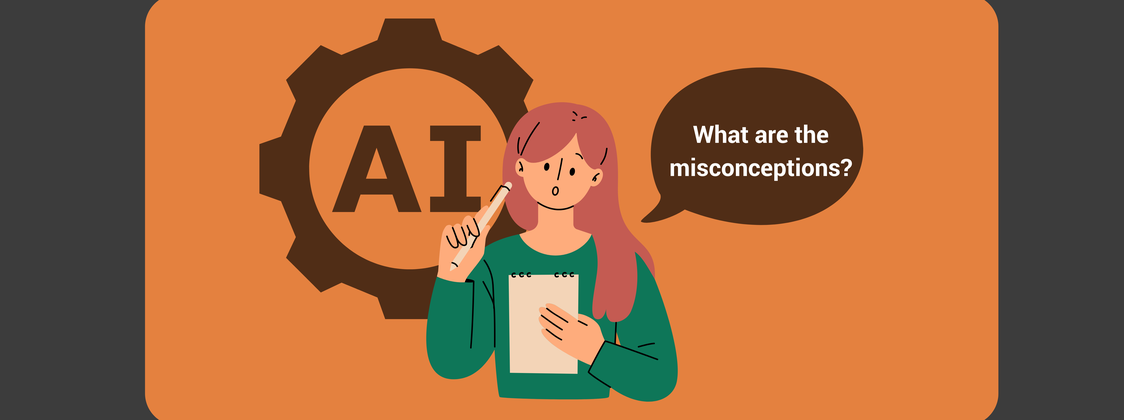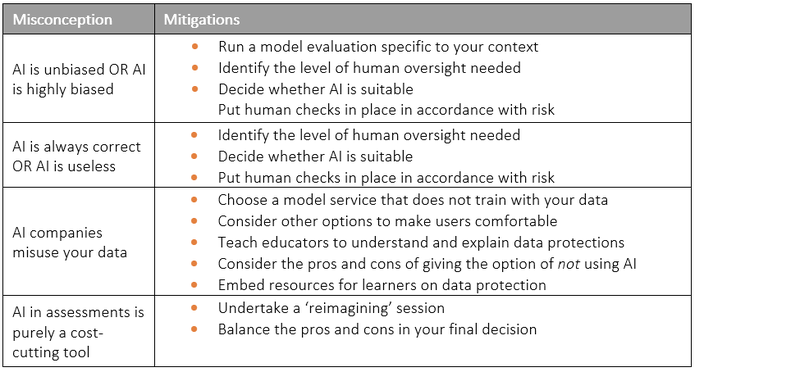From Vets to VET: Lessons from WorkMate’s AI model for Veterinarians
Article #8 of AI in Education Article Series: May 2025
Hear from Tom Brownlie, founder of veterinary AI tool WorkMate, and his tips for an educator using AI for assessment.
Article #9 of AI in Education Article Series: May 2025
What are four common misconceptions relating to the use of AI in education? Let's explore how education providers can manage them.

Written by

Superpower: Romance languages
Fixations: Sunday drives
Phoebe works predominantly in social and market research, as well as monitoring and evaluation. Her projects often involve large-scale surveying and interviewing, and more recently, Artificial Intelligence in education.
She began her journey to research and evaluation in Brazil in 2020, supporting projects on social services, gender violence and education, for NGOS, governments and intergovernmental agencies. Prior to this, she worked as an English language teacher for adults.
Outside of work, Phoebe loves history, languages, animals and the outdoors. Together with her partner, she offers support services for Latin American migrants in New Zealand.
Phoebe has a Conjoint Bachelor of Arts and Commerce in Marketing (Market Research), International Business and Spanish.
Artificial Intelligence (AI) opens up exciting opportunities in assessment and learner support. However, its successful use depends on understanding and addressing common misconceptions – both those held by learners and educators. This article explores four common misconceptions relating to the use of AI for assessments, as well as what education providers can do to manage them.
This article is the ninth in a series titled “AI in Education”, aimed at education providers interested in AI. The intention is for this series to act as a beginner’s guide to the use of AI in education, with a particular focus on AI agents. This series is being developed as part of a project to develop an AI agent for learner oral assessment, funded by the Food and Fibre Centre of Vocational Excellence (FFCoVE). We invite you to follow along as we (Scarlatti) document our learnings about this exciting space.
Note that this article reflects the views of Scarlatti as of May 2025. They do not necessarily represent the views of the Food and Fibre Centre of Vocational Excellence.
Some think that AI systems are neutral and objective, assuming they do not carry bias. Others think that AI is highly biased.
In practice, the level of bias is somewhere in the middle, but improving. This is because AI systems reflect the data that they are trained on - including any historical biases within that data (Wellner, 2020) and how they are aligned. These systems can also lack understanding of Indigenous knowledge such as Mātauranga Māori, as they’re usually trained on data from dominant Western contexts (Ministry of Education, 2024). This means that the way that individual AI systems are designed and trained directly impacts whether its models produce biased or non-biased outputs.
As of May 2025, audits show that the newest large language models display smaller but still measurable demographic biases. Armstrong et al. (2024) documented sizable gender and race gaps in GPT-3.5. A more recent multi-model audit by Gaebler et al. (2025) finds that overt hiring-style gender preferences are now only a few percentage points, indicating progress, though not full elimination. Meanwhile, subtler stereotype and intersectional effects persist, as shown by Bai et al. (2025) and Salinas et al. (2025). We suggest that it remains essential to consult the newest evaluations for each model and to run context-specific audits before deploying an agent.
Some believe that AI outputs are always accurate and reliable. While others believe that AI is useless for assessments.
Like misconception 1, the reality is somewhere in the middle of these misconceptions. AI’s accuracy (and therefore its useability) largely depends on the quality of the training data and the design of the model. Over the last year, AI models have only gotten more accurate, with notable improvements seen in the quality of training data and algorithmic efficiency.
During our oral assessment agent pilots, we found that tutors agreed with the AI grade at least 94% of the time. The most common cause of AI giving incorrect grades or feedback has been when there is vagueness or missing information in the original content used to prompt the AI (in our case, grading rubrics, course content and past answers). However, there are likely still differences between an AI grader and a human grader. For example, a human teacher can adjust for context, learning needs, or misunderstandings, and reward points for originality, insight or learner improvement over time.
Users worry that AI systems will automatically collect and misuse their personal data during their assessment.
As of May 2025, most AI models now offer control over data sharing. For example, Claude does not use user data for training by default. ChatGPT allows users to opt-out in its settings. Scarlatti’s agent has been built using a secure API connection to OpenAI models, which do not use user data for training by default. Despite this, we acknowledge that there are misconceptions (and therefore concerns) about OpenAI’s use of data.
AI is only used to convert existing assessments into a new format (e.g., written to oral) to reduce costs.
While AI can reformat content (e.g., turning a written quiz into a voice-based quiz) to reduce costs, we think its greatest potential is in reimagining assessment. Oral AI allows for assessments that are more dynamic, conversational, and aligned to the real-world skills we want learners to build — such as verbal reasoning, negotiation, and critical reflection.

There are a number of misconceptions around AI in education, which may influence whether you want to adopt AI or not. Importantly, these misconceptions are evolving, as a result of the AI models themselves changing, but also our shared understanding of them – whether fuelled by evidence or not. It is highly likely that shortly after publishing this article, the situation will change all over again.
Questions that we are asking for our own AI agent:
Interested in following our journey into AI?
Bai, X., Wang, A., Sucholutsky, I., & Griffiths, T. (2025). Explicitly unbiased large language models still form biased associations. Proceedings of the National Academy of Science of the United States of America 122 (8). Retrieved 24 April 2025, from https://pubmed.ncbi.nlm.nih.gov/39977313/#:~:text=independently%2C%20are%20more%20diagnostic%20of,unbiased%20according%20to%20standard%20benchmarks
Department of Internal Affairs, National Cyber Security Centre & Stats NZ. (2023a). Initial Advice on Generative Artificial Intelligence in the Public Service. Retrieved January 8, 2025, from https://www.digital.govt.nz/assets/Standards-guidance/Technology-and-architecture/Generative-AI/Joint-System-Leads-tactical-guidance-on-public-service-use-of-GenAI-September-2023.pdf
Gaebler, J., Goel, S., Huq, A., & Tambe, P. (2025). Auditing large language models for race and gender disparities: Implications for artificial intelligence-based hiring. Behavioural Science and Policy 11 (1), 1-10.
Ministry of Education. (2024, November 25). Generative AI: Guidance and resources for education professionals on the use of artificial intelligence in schools. Retrieved 24 April 2025, from https://www.education.govt.nz/school/digital-technology/generative-ai
Office of the Privacy Commissioner. (2023). Artificial intelligence and the information privacy principles. Retrieved January 8, 2025, from https://privacy.org.nz/assets/New-order/Resources-/Publications/Guidance-resources/AI-Guidance-Resources-/AI-and-the-Information-Privacy-Principles.pdf
Salinas, A., Haim, A., & Nyarko, J. (2025). What’s in a Name? Auditing Large Language Models for Race and Gender Bias. Stanford University Human Centred Artificial Intelligence. Retrieved 24 April 2025, from https://hai-production.s3.amazonaws.com/files/2024-06/(Nyarko,%20Julian)%20Audit%20LLMs.pdf
Wellner, G. P. (2020). When AI is gender-biased: The effects of biased AI on the everyday experiences of women. Humana Mente, 13(37), 127-150. Retrieved 24 April 2025, from https://www.humanamente.eu/index.php/HM/article/view/307/273